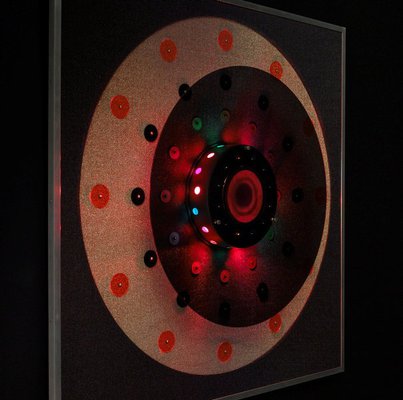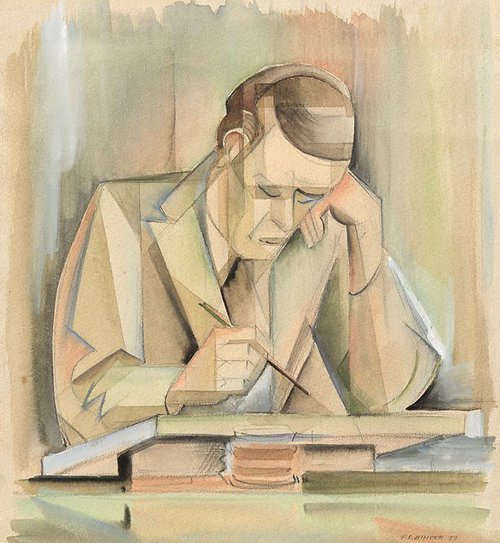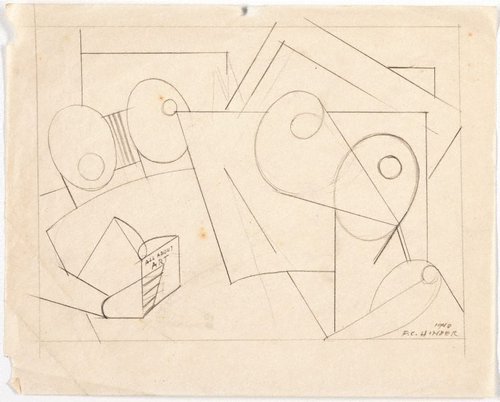

-
Details
- Other Title
- Mandala II
- Date
- 1973
- Media categories
- Sculpture , Time-based art
- Materials used
- hardboard, plywood, aluminium, acrylic glass, electric motor, optical fibre lights, plastic
- Dimensions
- 122.3 x 122.4 x 14.8 cm
- Signature & date
Signed bot. c. verso on plywood, pencil "F.C. HINDER". Not dated.
- Credit
- Purchased with funds provided by the Barbara Tribe Bequest 2014
- Location
- Not on display
- Accession number
- 97.2014
- Copyright
- © Estate of Frank Hinder
- Artist information
-
 Frank Hinder
Frank Hinder
Works in the collection
- Share
-
-
About
In the late 1960s, Frank Hinder brought the initial phase of Sydney modernism, with its overarching concerns of colour and light abstraction; and of science and spirituality, to its logical conclusion when he began to work on a series of light sculptures that he termed 'luminal kinetics'. Using mechanised systems of colour filtrations of light, projected through theatre lighting gels, cut out forms and distorted glass, Hinder explored an art of immersive colour sensations where "colour was freed from the limitations of pigment and the need to imitate". (John Henshaw, Hemisphere, August 1971)
Hinder's 'luminal kinetics' where not random light placements, but rather like his paintings, each sculpture's construction was carefully composed with the effects of light movement varying from work to work. As James Gleeson reported with they were first exhibited in 1968 "Some are vague and mysterious as ghosts materialised in vaporous mother of pearl while others are more precise and take us into the world of the computer." (James Gleeson, 'Art review: master of new form' in The Sun, October 23 1968)
Hinder's interest in mechanised notions of colour and light was triggered in 1928, when the artist was studying in Chicago and saw a performance of Thomas Wilfred on his 'Clavilux' - a silent keyboard which projected coloured light patterns onto a white screen without sound (a form of art which he termed 'Lumina'). Six years later he assisted German émigré artist and scholar in Sydney Elenore Lange with her conception of the 'Seraph of light' 1934, a proposed commission for a memorial sculpture which she conceived as using moving light and colour. Lange's idea of 'sculpting in light' deeply influenced Hinder's and encouraged his deep interest in exploring light both in terms of its metaphysical and scientific components.
When Hinder began producing his own 'luminal kinetic' works in 1967 he was attuned to international developments in the use of light and sculptural forms - in the works of Lucio Fontana, Frank Malina and Dan Flavin for example. Hinder's own mechanised systems produced changing colour movements in seeming infinite variations of hues. He first exhibited his luminal works at Von Bertouch Galleries in Newcastle in 1968, and then initially in Sydney at Gallery A in 1973 where both 'Mandala I' and 'Mandala II' were first exhibited.
'Mandala I' and 'Mandala II' are constructed from a mechanised rotational system propelling by a slowly expanding and dissolving motion of coloured lights. Intended to reference the celestial paths of the sun and the moon, these works draw on the light sculpture medium to suggest the infinite; the dynamics and movements of the cosmos. The circulating movements of gem-like speckles of light that pulsate out of darkness provide a dramatic feel of suspended luminosity. Colour, as a component of light, had been of central importance throughout Hinder's artistic practice. In these 'luminal kinetic' works, coloured light is aligned with a sense of the metaphysical and unleashed as the very substance of his art.
-
Exhibition history
Shown in 4 exhibitions
Frank Hinder: Luminal kinetics, Gallery A (Sydney), Paddington, 20 Oct 1973–Unknown
Frank and Margel Hinder 1930-1980, Art Gallery of New South Wales, Sydney, 12 Jun 1980–13 Jul 1980
Great Australian artist (with Margel Hinder), Bloomfield Galleries, Australia, 02 Aug 1994–21 Sep 1994
20th-Century galleries, ground level (rehang), Art Gallery of New South Wales, Sydney, 20 Aug 2022–2023
-
Bibliography
Referenced in 5 publications
-
Renée Free, The art of Frank Hinder, 'List of illustrations', pg. 8-10, Sydney, 2011, 9, 155 (colour illus.), 156.
-
Renée Free, Frank and Margel Hinder 1930 - 1980, 'Catalogue', pg. 15-28, Sydney, 1980, 27. cat.no. 256; titled 'Mandala II'
-
Gallery A (Sydney) (Compilator), Frank Hinder: Luminal kinetics, Sydney, 1973, n.pag.. cat.no. 7; titled 'Mandala II'; priced $1,500
-
Dr Cassi Plate., Sydney 6 - Hinders, Lewers, Plates: abstract artists, friends, partners, siblings, 1940s-1970s, 'The universal language of abstract art', Newcastle, 2015, n.pag.. general reference to Hinder's 'Luminal kinetics'
-
John Saxby, Look, 'A window opens on new stories about building the collection', pg. 26-28, Sydney, May 2015, 28.
-




